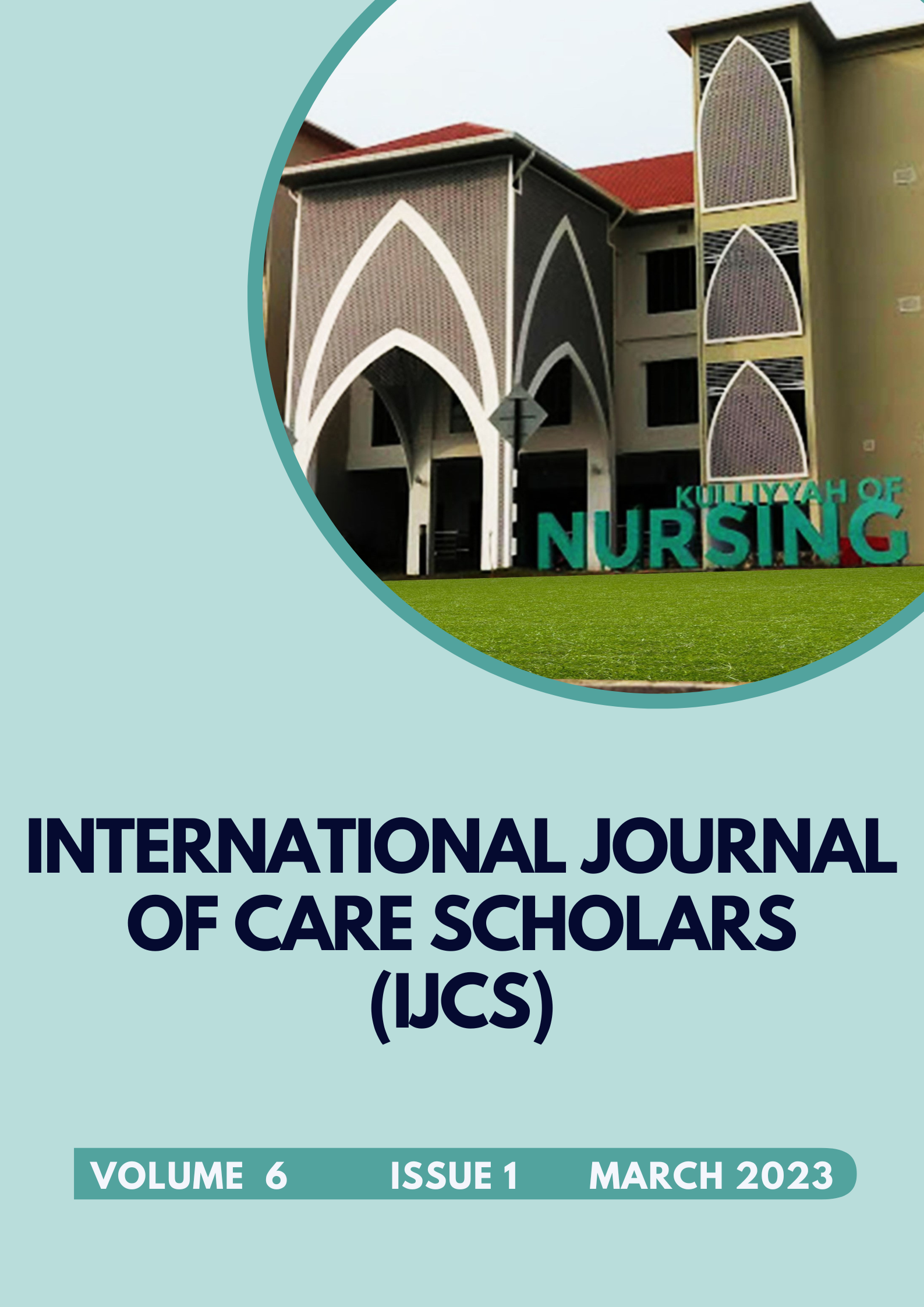The Experience of Patients with Breast Cancer at Home During Chemotherapy Treatment: A Qualitative Approach
DOI:
https://doi.org/10.31436/ijcs.v6i1.296Keywords:
Breast cancer, Chemotherapy, Experience, Home, QualitativeAbstract
Introduction: Cancer is the primary cause of death worldwide and a significant barrier to increasing life expectancy. The estimates from World Health Organization (WHO) in 2019, cancer is the first or second leading cause of death before the age of 70 in 112 of 183 countries and ranks mortality third or fourth in 23 countries. Patients with breast cancer in Malaysia have one of the lowest survival rates in the Asia-Pacific region, with a 5-year survival of only 49%, compared with up to 90% in the United States. Chemotherapy is a type of cancer treatment that uses one or more anti-cancer drugs as part of a standardized chemotherapy regimen. It may be given with a curative intent (which almost involves combinations of drugs), or it may aim to prolong life or reduce symptoms (palliative). The challenges for the patient in dealing with the side effects of the chemotherapy treatment begin while they are at home.
Objective: To explore the experience of patients with breast cancer at home during chemotherapy treatment.
Methods: This study employed a qualitative research design involving 20 patients with breast cancer undergoing chemotherapy treatment. The participants were recruited via purposive sampling and data were collected by semi-structured interview with recorded. The thematic analysis approach was used to analyze the data.
Results: Two themes were revealed: including emotional changes and physiological changes. This theme revealed the preference described by emotional changes with the explanation of physiological changes.
Conclusion: Patients with breast cancer not only experience the side effects of chemo drugs but also have to deal with the changes at home during chemotherapy treatment. There is a need for healthcare workers in Malaysia to be able to provide support, especially in terms of emotional and physiological support at home for patients with breast cancer.
References
Bray, F., Laversanne, M., Weiderpass, E., & Soerjomataram, I. The ever?increasing importance of cancer as a leading cause of premature death worldwide. Cancer, 2021. 127(16),3029–3030. doi:10.1002/cncr.33587
Hyuna Sung, Jacques Ferlay, Rebecca L Siegal, Mathieu Laversanne, Isabelle Soerjomataram, Ahmedin Jemal, Freddie Bray. Global Cancer Statistic 2020: GLOBOCAN Estimates of Incidence and Mortality Worldwide for 36 Cancers in 185 Countries. CA Cancer J Clin. 2021 May;71(3):209-249. doi: 10.3322/caac.21660
National Cancer Institute.cancer.gov. "What is cancer?". National Institutes of Health. 2018. Available https://www.nih.gov/about-nih/what-we-do/nih-almanac/national-cancer-institute-nci
American College of Surgeons. "Five Things Physicians and Patients Should Question". American College of Surgeons. 2013. Available https://www.choosingwisely.org/societies/american-college-of-surgeons/
Ministry of Health Malaysia. National Strategic Plan For Cancer Control Programme 2016-2020. Ministry of Health Malaysia. 2016. Available https://www.moh.gov.my/moh/resources/Penerbitan/Rujukan/NCD/Kanser/National_Strategic_Plan_Book_final@25SEPT2017.pdf
Ruland, C. M., Andersen, T., Jeneson, A., Moore, S., Grimsbø, G. H., Børøsund, E., & Ellison, M. C. Effects of an Internet Support System to Assist Cancer Patients in Reducing Symptom Distress. Cancer Nursing, 2013, 36(1), 6–17. doi:10.1097/ncc.0b013e31824d90d4
Ullgren, H., Tsitsi, T., Papastavrou, E., & Charalambous, A. How family caregivers of cancer patients manage symptoms at home: A systematic review. International Journal of Nursing Studies, 2018, 85,68–79. doi:10.1016/j.ijnurstu.2018.05.004
Hoffman, A. J. Enhancing self-efficacy for optimized patient outcomes through the theory of symptom self-management. Cancer Nurs. 2013, 36(1): E16–26
Molassiotis, A., Brearley, S., Saunders, M., Craven, O., Wardley, A., Farrell, C., Swindell, R., Todd, C., Luker, K. Effectiveness of a Home Care Nursing Program in the Symptom Management of Patients With Colorectal and Breast Cancer Receiving Oral Chemotherapy: A Randomized, Controlled Trial. Journal of Clinical Oncology, 2009, 27(36), 6191–6198. doi:10.1200/jco.2008.20.6755
Beaver K, Williamson S, Briggs J. Exploring patient experiences of neo-adjuvant chemotherapy for breast cancer. Eur J Oncol Nurs. 2016; 20:77–86
Speck R. M., DeMichele A., Farrar J.T., Hennessy S., Mao J. J., Stineman M. G., Barg F. K. Taste alteration in breast cancer patients treated with taxane chemotherapy: experience, effect, and coping strategies. Support Care Cancer. 2013;21(2):549–555. doi: 10.1007/s00520-012-1551-3
Kwok A, Palermo C, Boltong A. Dietary experiences and support needs of women who gain weight following chemotherapy for breast cancer. Support Care Cancer. 2015;23(6):1561–1568
Sutton J, Austin Z. Qualitative Research: Data Collection, Analysis, and Management. Can J Hosp Pharm. 2015;68(3):226–231
Guest G, Bunce A, Johnson L. How many interviews are enough? An experiment with data saturation and variability. Field methods. 2006;18(1):59–82
Creswell JW. Quality inquiry and research design: Choosing among five traditions. California: Thousand Oaks; 1998
Morse JM. Designing funded qualitative research. In: Denizin NK, Lincoln YS, editors. Handbook of qualitative research. 2nd ed. California: Thousand Oaks; 1994
Vaismoradi M, Jones J, Turunen H, Snelgrove S. Theme development in qualitative content analysis and thematic analysis. J Nurs Educ Pract. 2016;6(5):100
Mojtaba V, Hannele T, Terese B. Content Analysis and Thematic Analysis: Implications for Conducting A Qualitative Descriptive Study. Nursing and Health Sciences, 2013; 15 (3)
Maryann N., Center for Medical Consumers Breast Cancer Chemotherapy: Adverse Effects Higher Than Reported in Clinical Trials. HEALTHFACTS. 2006. Available http://www.encognitive.com/files/Breast%20Cancer%20Chemotherapy--Adverse%20side%20effects.pdf
Chan HK, Ismail S. Side effects of chemotherapy among cancer patients in a Malaysian General Hospital: experiences, perceptions and informational needs from clinical pharmacists. Asian Pac J Cancer Prev. 2014;15(13):5305–5309
Lai XB, Ching SSY, Wong FKY. A qualitative exploration of the experiences of patients with breast cancer receiving outpatient-based chemotherapy. J Adv Nurs. 2017;73(10):2339–2350
Nies, Y. H., Mhd Ali, A., Abdullah, N., Islahudin, F., & Mohamed Shah, N. A qualitative study among breast cancer patients on chemotherapy: experiences and side-effects. Patient Preference and Adherence, 2018, 12;1955–1964. doi:10.2147/ppa.s168638




